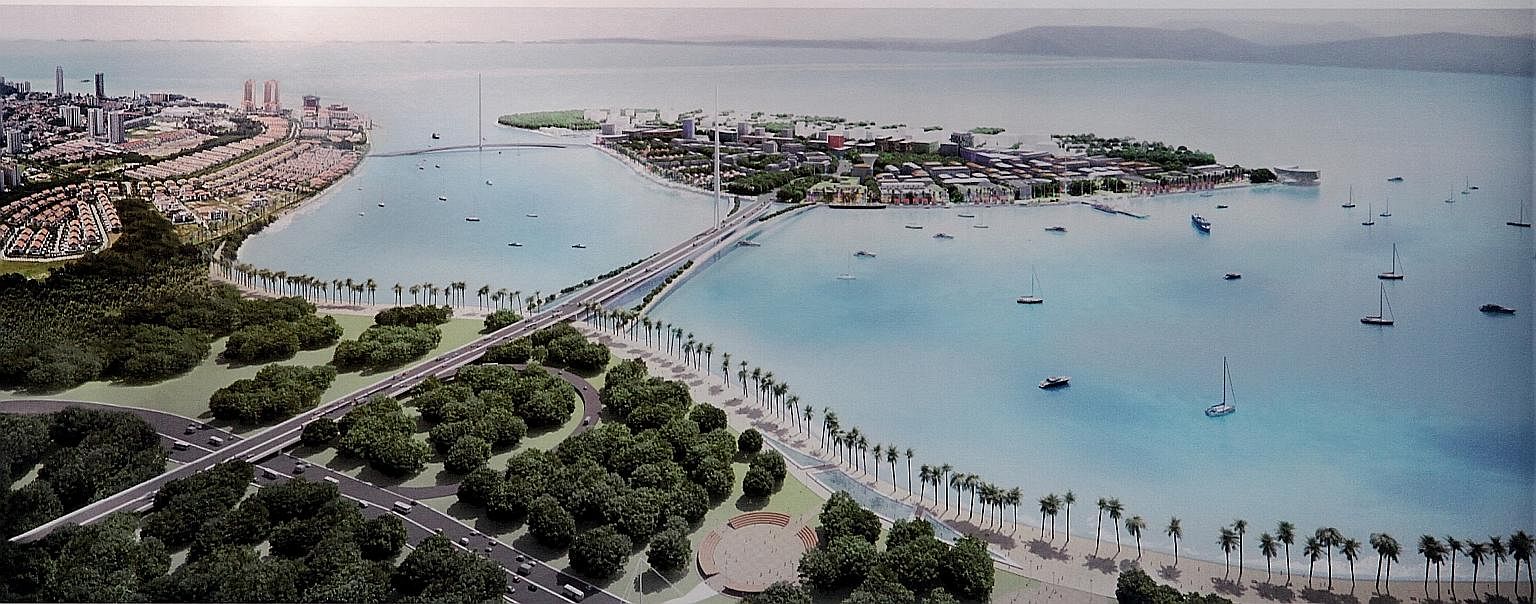Mr Murad Sirun leans against his small single-motor fishing boat in the fishing village on the outskirts of Penang's capital George Town and laments how he is struggling to keep up repayments on a loan he took to repair his home that was damaged by the tsunami that hit the island 12 years ago.
Pointing to the azure waters of the narrow channel that separate the island from mainland Peninsular Malaysia, Mr Murad, 63, gripes about a possible new threat in his already tough life.
Just offshore, large dredging ships suck up thousands of cubic metres of mud to prepare the seabed for Penang's most ambitious reclamation project. Architects of the project, covering 53ha along the island's famed tourist destination of Gurney Drive, intend to create an iconic seafront park and lifestyle precinct. There will also be a new, separate island covering another 308ha for a new township, about 60 per cent the size of Singapore's Sentosa island.
"We barely make enough from the daily catch of fish and prawns because of poaching from foreign fishing vessels that are better equipped," says Mr Murad, who has been a fisherman for nearly 50 years.
Says another fishermen who wants to be known only as Jasman: "The government does not care about us. What we hear is that they are building an island and our livelihood will be destroyed."
Penang Chief Minister Lim Guan Eng, chief promoter of the economic transformation agenda that includes the giant reclamation works, looks at things differently.

He says that the pockets of dissent are missing the big picture over his administration's push to turn Penang into a hub for knowledge-based economic activities and set the stage for the island's move into a high-income economy.
"Whether I stay or go, the government is solidly behind these projects," says Mr Lim, secretary-general of the opposition Democratic Action Party. He is facing corruption charges - which he says are politically motivated - for abusing power.

He says the land reclamation projects are the lynchpin of a growth plan that will help finance a clutch of highway networks and an ambitious tunnel that will become the third link after the existing two bridges that connect Penang island to the mainland.
"We are hampered by traffic congestion and once we solve this, the island will become very liveable and attract knowledge-based economic activities which will allow Penang to compete with secondary cities like Bali and Phuket," he tells The Straits Times.
He says that "we are not sparing any expenses", noting that top- notch consultants and architects have been engaged to design an iconic sea-fronting public park and lifestyle suburb that will feature bicycle tracks, gardens and a retail and restaurant hub on the reclaimed Gurney Drive project.
The consultants include Grant Associates, which led the design of Singapore's Gardens by the Bay, and Jerde Partnership, which was the driving force behind Japan's Roppongi Hills development.
The central player in Mr Lim's vision for a transformed Penang is property developer Eastern & Oriental (E&O), which in 2003 assumed the rights and obligations of a longstanding concession to reclaim over 396ha of land on the north-eastern coast of the island around the Tanjung Tokong area.
The first phase of the concession was the reclamation of 97ha of land under the Seri Tanjung Pinang mixed development. When the project was launched in 2005, analysts attached a gross development value (GDV) of RM1.5 billion (S$502 million). After 11 years and successive launches of landed and condominium units, the project's estimated GDV is in excess of RM5 billion, E&O says.
E&O managing director Kok Tuck Cheong says the group will now be reclaiming 102ha, along with another 53ha along the Gurney Drive foreshore for the Penang state government. The reclamation works, costing RM2.3 billion, are expected to be completed in the second half of 2018. Mr Kok says the company is in discussions with potential cornerstone investors.
The reclamation projects are a crucial cog in the state's economic vision. That is because Mr Lim's government is hoping to finance the construction of three major road networks and the tunnel project through a land swap deal involving 45ha reclaimed by E&O.
The road projects have been awarded to a consortium comprising Malaysian contractor Zenith Construction and China's Beijing Urban Construction Group (BUCG), the company that built China's National Stadium. The price tag for construction is tagged at RM6.34 billion and, apart from the land swap, the Zenith-BUCG group will also get a 30-year concession to operate the tunnel.
But the plan to transform Penang's physical and social fronts is triggering a backlash.
Penang civil society groups have attacked Mr Lim for the haste with which the project was awarded to the Zenith-BUCG consortium and the lack of public consultation on the government's decision to proceed with the highway and undersea tunnel, which they say could impact on the movement of cargo ships to the Penang port.
Zenith executive director Wong Kwai Wah says that the company will meet conditions under an environment impact assessment which should be completed in the coming months. He says Penang trails other islands such as Singapore and Hong Kong where road networks have been vital to economic success.
Mr Lim acknowledges the opposition to the projects, pointing out that "the criticisms from the NGO groups are to be expected but they can be explained".
"If we pull it off, we can ensure prosperity for Penang not just for the next 15 years, but the next 50 years," he says.
